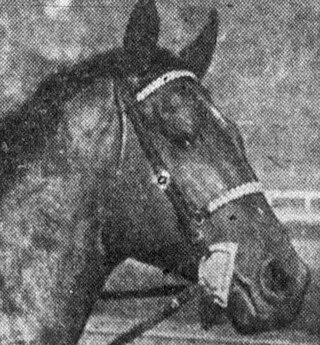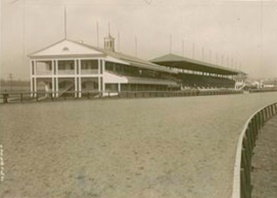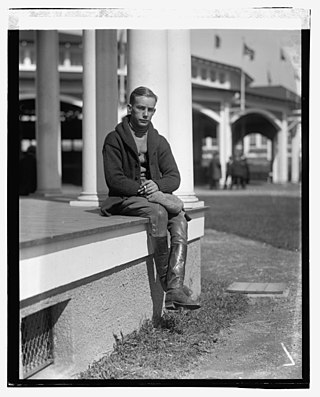Related Research Articles
Equipoise (1928–1938) was an American Thoroughbred racehorse and sire. In a career which lasted from 1930 until 1935, he ran fifty-one times and won twenty-nine races. A leading two-year-old in 1930, he missed most of the next season, including two of the three American Triple Crown races through injury and illness. "Ekky" returned to the track in 1934 and proved to be a dominant champion, winning numerous important stakes races in the next three years. Equipoise died in 1938 after a short but promising stud career.

Whirlaway was a champion American Thoroughbred racehorse who is the fifth winner of the American Triple Crown. He also won the Travers Stakes after his Triple Crown sweep to become the first and only horse to win all four races.

George Monroe Woolf, nicknamed "The Iceman", was a Canadian thoroughbred race horse jockey. An annual jockey's award given by the United States Jockeys' Guild is named in his honor. He became known for riding the people's champion Seabiscuit to victories in 1938.
Craig Perret is an American thoroughbred horse racing jockey. He began riding horses at age five and by seven was riding quarter horses in match races. At age fifteen he began his career in thoroughbred racing and in 1967 was the leading apprentice jockey in the United States in terms of money won.
Reigh Count was an American Hall of Fame Thoroughbred racehorse who won the 1928 Kentucky Derby and the 1929 Coronation Cup in England.

Challedon (1936–1958) was an American Hall of Fame Champion Thoroughbred racehorse. Bred in Maryland by William L. Brann and Robert S. Castle, he raced under the colors of their Branncastle Farm.

The Havre de Grace Racetrack was an American horse racing track on Post Road in Havre de Grace, Harford County, Maryland. Nicknamed "The Graw," it operated from August 24, 1912, to 1950. For a time, it was owned by the Harford Agricultural and Breeders Association and also by the notorious gambler Arnold Rothstein.
Cudgel (1914–1941) was an American two-time Champion Thoroughbred racehorse.
Menow (1935–1964) was an American Thoroughbred racehorse. He won several important races in 1937, when he was voted American Champion Two-Year-Old Male Horse.
Gregory Duncan "Don" Cameron was an American Thoroughbred horse trainer who trained Count Fleet, who won the U.S. Triple Crown in 1943.

Milkmaid was an American two-time Champion Thoroughbred racehorse. She was bred by J. Hal Woodford at his farm in Bourbon County, Kentucky. Woodford had bred and raced the 1907 Kentucky Derby winner, Pink Star. Out of the mare, Nell Olin, her sire was the British import, Peep o' Day, a son of the great Ayrshire who won the 1888 2,000 Guineas Stakes and Epsom Derby then just missed winning the British Triple Crown when he ran second in the St. Leger Stakes.
Pavot was an American Thoroughbred Champion racehorse. In a career that lasted from 1944 to 1946 he ran thirty-two times and won fourteen races. He was the leader of his generation in 1944 when he was named American Champion Two-Year-Old Colt. The following year he recorded his most important win in the Belmont Stakes.
The Narragansett Special was an American Thoroughbred horse race run annually at Narragansett Park in Pawtucket, Rhode Island. At the time of its inaugural running in 1934, the Narragansett Special offered a purse of $32,500 added money making it the biggest race run at the track. Only Suffolk Downs' Massachusetts Handicap, which ran the next summer, had a bigger purse in New England. Both rich contests drew the best talent that the nation had to offer.

Charles John "Chick" Lang was a Canadian Hall of Fame jockey who became a National Champion rider in the United States and who won the most prestigious Thoroughbred horse race of both countries.
Vigil was an American Thoroughbred racehorse best known for winning the 1923 Preakness Stakes in a performance the Los Angeles Times called "the most brilliant victory in the history of the Preakness."
The Pimlico Spring Handicap was a race for Thoroughbred horses run annually from 1917 through 1932 at Pimlico Race Course racetrack in Baltimore, Maryland. The mile and one-sixteenth race on dirt was open to horses of either sex age three and older.
The Philadelphia Handicap was an American Thoroughbred horse race held thirty-eight times between 1913 and 1950 at Havre de Grace Racetrack in Havre de Grace, Maryland. Run on dirt, the race was open to horses of either sex age three and older.
The Chesapeake Stakes was an important American Thoroughbred horse race for three-year-old horses of either sex contested on dirt over a distance of a mile and one-sixteenth at Havre de Grace Racetrack in Havre de Grace, Maryland. Run from 1920 until the track closed after the 1950 edition, the race usually run in late April race was a last major prep before the Kentucky Derby. For owners who had not nominated their horse for the Derby it was a chance to test their horse's ability against some of the best three-year-olds in the country, a number of which they would undoubtedly encounter in the ensuing Preakness Stakes.
The Eastern Shore Stakes was an American Thoroughbred horse race run between 1913 and 1949 at Havre de Grace Racetrack, in Havre de Grace, Maryland. A race for two-year-old horses of either sex, it was inaugurated and run for most of its existence as the Eastern Shore Handicap.
William Lloyd Kelsay was one of the top jockeys in American Thoroughbred racing during the 1920s who was widely respected for his ability to handle two-year-old horses during their first year of racing.
References
- ↑ "Stakes To Hallenbeck Stable.: Adams Express Carries Top Weight to Victory". Daily Racing Form at University of Kentucky Archives. 1912-08-27. Retrieved 2019-11-06.
- ↑ "Lord Grillo Registers Havre Upset". Daily Racing Form at University of Kentucky Archives. 1949-05-02. Retrieved 2019-11-06.
- ↑ "How Havre de Grace's racetrack was once a gem". cecildaily.com. 2016-08-27. Retrieved 2019-11-05.
- ↑ "Havre De Grace Form Chart". Daily Racing Form at University of Kentucky Archives. 1919-09-28. Retrieved 2019-11-06.
- ↑ "Crusader is Victor as 25,000 Look On". New York Times. 1926-09-26. Retrieved 2019-11-04.
- ↑ "Valenciennes, filly, wins $20,000 Havre de Grace Cup". The Cincinnati Enquirer, page 35. 1931-10-04. Retrieved 2019-11-06.
- ↑ "Equipoise and Repaid Move Into the Center of the Racing Stage". Brooklyn Daily Eagle, page 20. 1932-10-03. Retrieved 2019-11-06.
- ↑ "$10,000 Added Test Goes to Seabiscuit". New York Times, page 34. 1938-09-29. Retrieved 2019-01-01.
- ↑ "Havre de Grace Handicap Goes To Challedon for second Time". New York Times, Section Sports, page 80. 1940-09-29. Retrieved 2019-11-06.
- ↑ "Natchez Sets New Track Record In Taking Havre de Grace Event". New York Times, Section Sports, page 4. 1948-07-18. Retrieved 2019-11-04.